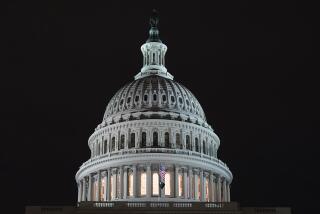Partisan Budget Fight Delays Debt Action
WASHINGTON — The Senate, amid intense partisan wrangling, began considering legislation Wednesday that would increase the federal debt limit to $2.6 trillion and prevent the government from defaulting on its bills by the end of this month.
Congressional leaders of both parties are confident that the debt limit will be increased before the government runs out of money. But long-standing disputes between the White House and Democrats over the budget deficit and other fiscal issues have delayed action.
Democrats are trying to use the debt increase bill as a vehicle for forcing President Reagan to choose between higher taxes or deep cuts in military spending. The White House is urging Congress to pass a “clean” bill increasing the debt limit and to tackle other budget issues in separate legislation.
Senate leaders from both parties met for several hours Wednesday trying to hammer out a bipartisan plan for raising the debt limit. But they failed to come up with any agreement and could be headed for a long, drawn-out debate over the next few days, according to one staffer.
Majority Leader Robert C. Byrd (D-W.Va.), who kept the Senate in recess for the entire day while the conferees met, said it would be “highly regrettable” if the debt limit legislation becomes submerged in the debate over a multitude of conflicting fiscal proposals.
Senate Minority Leader Bob Dole (R-Kan.) also urged his colleagues to find a rapid settlement to the debt limit question, noting that “payments for Social Security and veterans checks could be frozen by Aug. 3” if the Senate does not act.
The congressional budget resolution for fiscal 1988, strongly supported by Democrats, calls for $19 billion in new taxes, but the President has vowed to veto any tax hike. To head off a Reagan veto, Senate Democrats plan to attach an amendment strengthening the Gramm-Rudman budget cutting law to legislation increasing the federal debt ceiling.
The Gramm-Rudman law, which lays out a schedule of deficit reductions on a yearly basis and requires Congress to balance the federal budget by 1992, provides no penalties if Congress fails to meet deficit reduction targets. But Senate Democrats, joined by some Republicans, want to put teeth into the law with the addition of an automatic “trigger mechanism” that would mandate a $36-billion cut in the deficit each year.
If such an amendment is adopted, Democrats say, the President would be forced to choose between the tax hikes authorized by the congressional budget resolution or the Gramm-Rudman cuts--including $18 billion in defense expenditures, a prospect he has strongly opposed--as a way of reducing the deficit.
In a Tuesday meeting with Senate Republicans, Reagan and Budget Director James C. Miller III asked for a one-year extension of the debt ceiling, warning against the consequences of entangling the bill with other proposals.
But many Senate Democrats and Republicans--including Sens. Phil Gramm (R-Tex.) and Warren B. Rudman (R-N.H.), authors of the deficit reduction law--are reluctant to pass legislation increasing the debt ceiling without taking a crack at reducing the deficit. Democrats note with a trace of irony that Reagan, who enthusiastically supported the Gramm-Rudman law when it was passed in 1985, now seems to be “backing away from it,” according to California Rep. Tony Coelho (D-Merced), the House whip.
It would be politically risky for Reagan to veto a bill raising the debt ceiling, even if it contained distasteful budget provisions. The government technically exhausted its borrowing authority last Friday, when the debt ceiling dropped from $2.3 trillion to $2.1 trillion. Because the debt already exceeds $2.1 trillion, the Treasury can get no new credit without congressional action.
The House passed its own version of a debt limit increase in June when it approved a conference committee version of the budget resolution.
More to Read
Get the L.A. Times Politics newsletter
Deeply reported insights into legislation, politics and policy from Sacramento, Washington and beyond. In your inbox three times per week.
You may occasionally receive promotional content from the Los Angeles Times.










